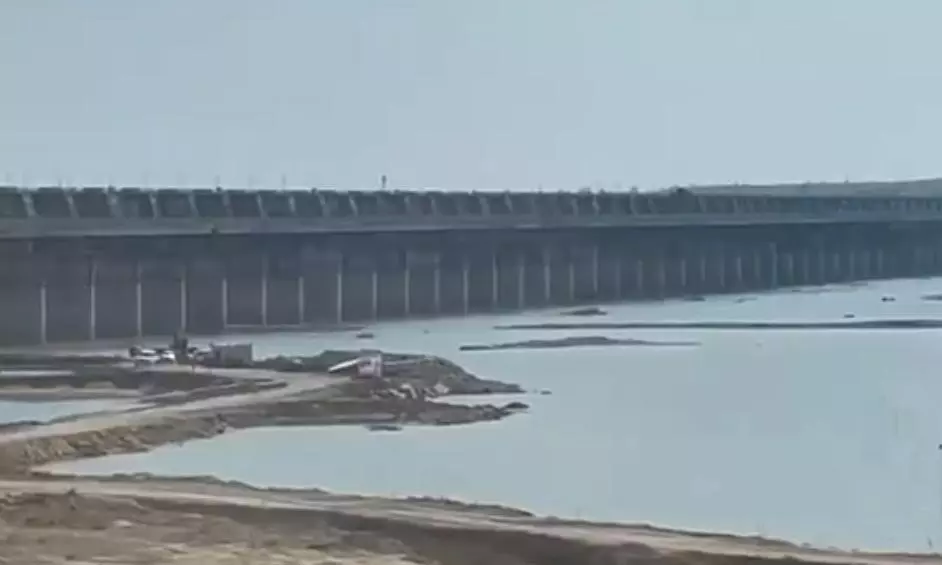Drying reservoirs in state result of short heavy rain spells last year

Hyderabad: Sounds counter intuitive, but the heavy rains resulting in overall good averages in terms of how much rain fell over Telangana last year, and even the flash floods that followed such rain spells, might have resulted in the drought-like conditions in the state today.
It was the BRS that was in power when this happened and was led by its president K Chandrashekar Rao as the chief minister. The party, of late, has been clamouring that the state had good rains last year and the current drought conditions are a result of the inefficiency of the new Congress government. And the Congress, with good reason, has hit back accusing the BRS and its then government of not speaking the truth, and trying to mislead people on the real situation.
It all boils down for the BRS to the cumulative rainfall during last monsoon in the state which stood at 837.8 mm, which the party has said, was more than the normal of 728.30 mm.
But the problem for the BRS is that much of this rain occurred in a matter of just 10 days in July 2023 — between July 18 and July 28.
And within this 10-day period, it was on just four days — July 21, 22, 25 and 27 — that bulk of the rainfall occurred, resulting in flash floods in Jayashankar Bhupalapally, Mulugu, Hanamkonda, Warangal, Mahabubabad, Jangaon, Bhadradri Kothagudem, Karimnagar, Jagtial and Adilabad districts, as well as floods in Warangal city.
The humongous amounts of rain in the second half of July 2023 and its impact can be gauged by the fact that till July 17, the cumulative rain in Telangana stood at 196 mm, a minus 20 per cent from normal for the monsoon period that began on June 1, 2023. And till July 17, none of the 33 districts in Telangana reported either large excess or excess of rain. Eleven districts reported normal rainfall, while 22 districts received less than what they normally should have during the same period resulting in a deficit status in these districts between June 1 and July 17.
However, the July rain surge meant that the districts, which got soaked, received 38 per cent of their annual rain in just four days. The cumulative rainfall jumped to 557.5 mm, representing a +66per cent deviation, which suddenly saw as many as 21 districts moving to the status of large excess, and 11 into the excess rainfall category.
By the end of the year, despite the early season heavy downpour spells, Telangana ended up with large deficits in 23 districts of its 33 districts. Just two districts reported normal rain, one reported large excess, and five had deficient rains.
“When the rains are spread out, that is when it actually matters when it comes to adding to storages. Sudden heavy spells, and flash floods mean letting the water that comes at high speeds and volumes during such periods out by opening gates of projects, just as the case was in 2019, and later again in 2022 at the Kaleshwaram barrages when Godavari and Pranahita received floods,” explained an official in the irrigation department.
It is a fallacy to believe that just because there were heavy rains in one or two spells and there was a lot of runoff, reservoirs can be filled. It does not work that way. Even if there is enough rain, there are factors like the runoff first quenching the soil, only after which the rest of the water can flow into streams, rivers, and into reservoirs, the official explained.
While this was the case, the 2023 monsoon was also not up to par in Maharashtra, and Karnataka, the two catchment states for the Krishna river.
According to official data, during 2023, Karnataka recorded a cumulative 872 mm of rainfall against its normal annual rainfall of 1153 mm, a deficit of 24 per cent, and of that state’s 31 districts, 12 recorded normal and 19 districts recorded deficit rainfall.
Though Maharashtra received normal rainfall during the monsoon, between June and September, the post monsoon rain reported a deficit of 38 per cent. In fact, the poor inflows into Krishna from Maharashtra, and the equally poor monsoon in Karnataka itself saw Karnataka declare a crop holiday in the ayacut served by the Narayanpur dam, the last big dam on the river in Karnataka before the river reaches Telangana. This in turn, deprived, according to officials, around 10 TMC of water that Telangana would have received as incidental drainage water into the river’s downstream areas.

